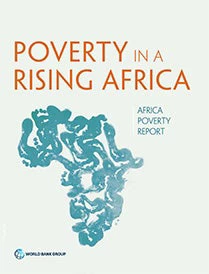
Following the adoption of the Millennium Development Goals in 2000, attention to education increased dramatically. At least in terms of enrollment, this seems to have paid off, so much so that education has lost its earlier top spot on the international development agenda. Since 2000, the solutions train has been set in motion, the illiteracy challenge seems to be taken care of, and attention has shifted elsewhere.
Against this background, the latest Word Bank report “Poverty in a Rising Africa” finds that 42% of Africa’s adults, about two in five, or a whopping 215 million people, are still illiterate, down from 46% in 1995. And make no mistake; this does not imply functional literacy for the remaining part of the population. The literacy tests applied are simply too rudimentary, and gross secondary school enrollment rates also only still stand at 46%.
These numbers should serve as an important wake-up call. Clearly, Africa’s human capital challenge, a key ingredient for successful structural transformation, is far from resolved, making the much needed modernization and diversification of its economies particularly challenging.
Part of the reason for this slow progress is that without adult literacy campaigns, rates can only be improved by the incoming cohorts. Their literacy levels are higher; among women 15-19 year olds are 11.5 percentage points less likely to be illiterate than 35-39 year olds. But, given the legacy of low initial levels, it simply takes time. Could adult literacy campaigns then not be part of the solution? Unfortunately, successful campaigns have so far remained few and far between. But, as UNESCO (2015, Chapter 4) documents, they also have never been given a full and fair shot.
Solving the illiteracy problem also requires an unrelenting focus on maximizing literacy rates among the incoming cohorts over sustained periods of time. Here, a lot of work remains as well. Unfortunately, better enrollment alone does not suffice. It does not equate with more learning. Despite (or because of) higher enrollment rates, actual learning has in fact often been limited with 36% of 6th graders in a sample of 15 Southern and Eastern African countries failing basic reading tests, according to the latest available standardized test scores. The number rises to 53% in a sample of 11 francophone West and Central African countries. Clearly, being enrolled is not enough.
Illiteracy especially high in West Africa
While both outcomes are alarming, there is also a wide variety in educational achievement across countries within the region. Yes, income levels matter, but it goes beyond that. High illiteracy rates are not inevitable. Rather, the contrary.
In seven African countries, more than half of the population is illiterate; almost all of them are in West Africa (Figure). Niger (with an adult literacy rate of only 15%) and Guinea (where the rate is just 25%) have the lowest literacy rates. At the other extreme, literacy levels exceed 90% in Equatorial Guinea and South Africa, and they exceed 70% in some poor and fragile countries as well, such as Eritrea and Zimbabwe. At 25%, the gender literacy gap remains high and it is especially large in West Africa, one reason for its elevated rates of illiteracy.
Figure: Literacy rates vary widely across countries
To unpack this a bit further, regression analysis using the female illiteracy rates from the Demographic and Health Surveys, as well as associated household traits and country characteristics, suggests that illiteracy rates are substantially higher in low income countries (by about 32 percentage points in upper-middle-income and high-income countries and about 14 percentage points in low-middle-income countries). But, as highlighted in last week’s Poverty-in-a-Rising-Africa blog, they are also three percentage points higher in resource rich countries compared to resource poor countries (irrespective of the country’s income level, landlockedness, or fragility), indicating that governance matters. Women in poor rural households are 36% more likely to be illiterate than their urban counterparts in richer households. Similar patterns likely hold for illiteracy among men, albeit to different degrees. We observe lower illiteracy for those who are divorced, widowed, or single (20% less likely to be illiterate).
No time for complacency
The analysis also confirms that literacy declines with age, holding hope both for gender parity and overall literacy levels. Yet, given the magnitude of the remaining deficit, and the time and sustained efforts it takes to build a nation’s human capital, renewed attention to Africa’s educational challenge by all stakeholders is overdue. After all, it concerns one of the most basic starting points, i.e. the ability to read, comprehend and write. And the world is also moving on, with greater returns to other skills that require foundation education as a basis.
On the upside, signs are that the world is waking up. A Framework for Action has already been adopted by UNESCO. In September 2016, the International Commission on financing Global Education Opportunities will report on how to fill the $39 billion a year external financing gap to meet Sustainable Development Goal 4. And the World Bank’s next World Development Report will dig deeper how interventions can be brought to scale and how countries can do better to “Realize the Promise of Education for Development,” its preliminary working title.
Yep, development is also about reading and writing again, and clearly, none of this is coming too early. One might tend to forget in this day and age of robots and digital jobs.
This blog is part of a series reflecting on the findings of the 2016 World Bank Report “Poverty in a Rising Africa." Next in the series: poverty and inflation in Africa on March 7, 2016. Previous blogs in the series include:
- Africa is rising! But are people better off?
- Who will fund poverty surveys in Volkswagen countries?
- The European refugee crisis: What we can learn from refugees in Sub-Saharan Africa
- Poverty is falling faster for female-headed households in Africa
- The shock of widowhood: Marital status and poverty within Africa
- Domestic Violence and Poverty in Africa: When a Husband’s Beating Stick is Like Butter
- Data gaps: The poor typical household survey’s miss
- Inequality of opportunity in Sub-Saharan Africa
- Is inequality in Africa rising?
- Education for all in a “rising Africa”
- When growth alone is not enough



Join the Conversation